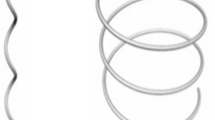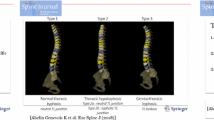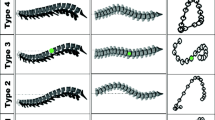Abstract
Several classification systems of the spinal curves in adolescent idiopathic scoliosis (AIS) have been developed to guide surgical decision-making. The current classification systems are based on the spinal deformity patterns or deformity magnitudes in one or two anatomical planes. Considering the 3D nature of the spinal deformity in AIS, these classifications fail to capture the spine’s curve in its entirety. We proposed a classification based on the axial plane and showed that mathematical analysis of the 3D spinal curve, using differential geometry, supports the differences between the subtypes in this classification system. We calculated the writhe and twist of the entire spinal centerline, elements of the Călugăreanu–White–Fuller theorem, in a cohort of 30 right thoracic AIS patients. We also classified this cohort manually based on the vertebral level at which the direction of vertebral rotation caudal to the thoracic curve changes: Lumbar in Group I (V-shaped axial projection) or thoracolumbar in Group II (S-shaped axial projection). The writhe and twist of the spinal curve were significantly different between these manual classification subgroups. Our manual classification distinguished the axial subgroups of right thoracic AIS supported by mathematical specifications of the entire curve in three dimensions.

Graphical abstract





Similar content being viewed by others
References
Adams CC (1994) The knot book. W.H. Freeman, New York
Banchoff TF, White JH (1975) The behavior of the total twist and self-linking number of a closed space curve under inversions. Math Scand 36(2):254–262
Dennis MR, Hannay JH (2005) Geometry of Călugăreanu's theorem. Proc R Soc A Math Phys Eng 461(2062):3245–3254
Duong L, Mac-Thiong JM, Cheriet F, Labelle H (2009) Three-dimensional subclassification of Lenke type 1 scoliotic curves. J Spinal Disord Tech 22:135–143
Illés T, Somoskeöy S (2013) Comparison of scoliosis measurements based on three-dimensional vertebra vectors and conventional two-dimensional measurements: advantages in evaluation of prognosis and surgical results. Eur Spine J 22:1255–1263
Kadoury S, Labelle H (2012) Classification of three-dimensional thoracic deformities in adolescent idiopathic scoliosis from a multivariate analysis. Eur Spine J 21:40–49
Kadoury S, Shen J, Parent S (2014) Global geometric torsion estimation in adolescent idiopathic scoliosis. Med Biol Eng Comput 52(4):309–319. https://doi.org/10.1007/s11517-013-1132-8
Klenin K, Langowski J (2000) Computation of writhe in modeling of supercoiled DNA. Biopolymers. 54(5):307–317
Lenke LG, Betz RR, Harms J, Birdwell KH, Clements DH, Lowe TG, Blanke K (2001) Adolescent idiopathic scoliosis: a new classification to determine extent of spinal arthrodesis. J Bone Joint Surg 83(8):1169–1181
Levitt M (1983) Protein folding by restrained energy minimization and molecular dynamics. J Mol Biol 170(3):723–764
Moffatt HK, Ricca RL (1997) Helicity and the Călugăreanu invariant. Proc R Soc Lond A 439:411–429
Pasha S (2019) 3D deformation patterns of S shaped elastic rods as a pathogenesis model for spinal deformity in adolescent idiopathic scoliosis. Sci Rep 9(1):16485
Pasha S (2019) 3D spinal and rib cage predictors of brace effectiveness in adolescent idiopathic scoliosis. BMC Musculoskelet Disord 20:384
Pasha S, Baldwin K (2019) Surgical outcome differences between the 3D subtypes of right thoracic adolescent idiopathic scoliosis. Eur Spine J 44(2):134–142
Pasha S, Cahill PJ, Dormans JP, Flynn JM (2016) Characterizing the differences between the 2D and 3D measurements of spine in adolescent idiopathic scoliosis. Eur Spine J 25(10):3137–3145
Pasha S, Hassanzadeh P, Ecker M, Ho V (2019) A hierarchical classification of adolescent idiopathic scoliosis: identifying the distinguishing features in 3D spinal deformities. PLoS One 14:e0213406
Pasha S, Schlosser T, Zhu X, Castelin R, Flynn J (2017) Application of low-dose stereoradiography in in vivo vertebral morphologic measurements: comparison with computed tomography. J Pediatr Orthop 39(9):487–494
Poncet P, Dansereau J, Labelle H (2001) Geometric torsion in idiopathic scoliosis: three-dimensional analysis and proposal for a new classification. Spine 26(20):2235–2243
Sangole AP, Aubin CE, Labelle H, Stokes IA, Lenke LG, Jackson R, Newton P (2009) Three-dimensional classification of thoracic scoliotic curves. Spine (Phila Pa 1976) 34:91–99
Stokes IA, Sangole AP, Aubin CE (2009) Classification of scoliosis deformity three-dimensional spinal shape by cluster analysis. Spine (Phila Pa 1976) 34:584–590
Author information
Authors and Affiliations
Corresponding author
Ethics declarations
Disclosures
The manuscript submitted does not contain information about medical devices/drugs.
Conflict of interest
The authors declare that they have no conflict of interest.
Ethics committee approval
This study was approved by the IRB at The Children’s Hospital of Philadelphia. All ethical guidelines and rules were followed to protect patient privacy.
Additional information
Publisher’s note
Springer Nature remains neutral with regard to jurisdictional claims in published maps and institutional affiliations.
Level of evidence: 3
Electronic supplementary material
ESM 1
(DOCX 2.14 kb)
Video 1
Writhe is the fraction of surface area covered when the curve is projected onto the unit sphere from each point on the curve. This animation demonstrates said projection using a scoliotic spinal curve represented as a chain of line segments. The green is the positive projections based on definition whereas the red is negative projection. The writhe of the curve is the final some of these areas expressed as a fraction of the total surface area of the sphere. (MP4 2195 kb)
Rights and permissions
About this article
Cite this article
Arginteanu, T., DeTurck, D. & Pasha, S. Global 3D parameter of the spine: application of Călugăreanu–White–Fuller theorem in classification of pediatric spinal deformity. Med Biol Eng Comput 58, 2963–2969 (2020). https://doi.org/10.1007/s11517-020-02259-w
Received:
Accepted:
Published:
Issue Date:
DOI: https://doi.org/10.1007/s11517-020-02259-w




